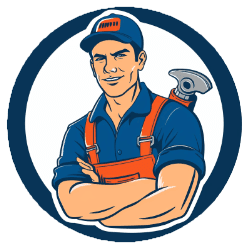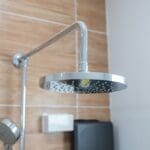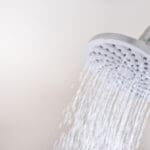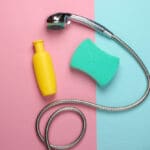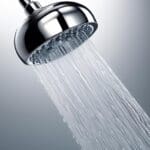Isn’t it a coincidence that the moment you’re looking forward to a soothing shower, you’re met with a trickle instead of a powerful spray? You’re not alone in this frustration. Luckily, boosting your shower head’s pressure doesn’t have to be a daunting task.
By starting with a thorough cleaning to remove any blockages, checking and potentially removing the flow restrictor, ensuring the main valve is fully open, repairing any leaks, and considering an upgrade to a high-pressure showerhead, you’ll set yourself on a path to more invigorating showers.
Each step is straightforward and can lead to significant improvements in water flow. So, if you’re ready to transform your lackluster shower into a more powerful and refreshing experience, let’s explore these steps further and uncover how simple adjustments can make a vast difference.
Key Takeaways
- Clean and inspect the showerhead, filter, and rubber nozzles for optimal performance.
- Remove or adjust the flow restrictor to improve water flow and pressure.
- Ensure all water valves are fully open to maximize water flow to the shower.
- Address leaks promptly and consider upgrading to a high-pressure showerhead for better pressure.
Inspect and Clean Your Showerhead
To boost your shower’s water pressure, start by unscrewing and thoroughly cleaning your showerhead to clear any blockages. Over time, mineral deposits can accumulate, leading to a drop in the water flow. By removing these deposits, you’re taking a crucial step to increase shower head pressure.
If your shower head has a filter, ensure it isn’t clogged. A blocked filter can significantly reduce water flow, making your pressure seem low.
Also, pay attention to the individual rubber nozzles. These can be prone to blockages, affecting the overall shower water pressure. Cleaning them might just be the fix you need to restore optimal performance. During this process, inspect for any leaks. A leaking shower head can contribute to low pressure and waste water. If you find any issues that you can’t fix, don’t hesitate to call a professional plumber.
If your pressure is still low after cleaning, consider replacing your shower head with a model designed for low water pressure. These are specifically engineered to increase shower water flow, offering an affordable solution to improve your shower experience.
Remove or Adjust the Flow Restrictor
After inspecting and cleaning your showerhead, another step you can take to enhance water pressure is removing or adjusting the flow restrictor. If you’re experiencing low water pressure, this could be due to a flow restrictor in your showerhead designed to conserve water. However, in areas with naturally low water pressure, this feature can turn your shower into a low-pressure shower head, making your shower experience less than ideal.
First, identify if your showerhead has a flow restrictor. Consult the user manual or manufacturer’s instructions for guidance. These restrictors are often easy to spot once you know what you’re looking for, usually a plastic disc located inside the showerhead with tiny holes that limit water flow.
Using a screwdriver or pliers, carefully remove the flow restrictor if it’s designed to be removable. Sometimes, simply cleaning it to remove debris or mineral buildup can significantly increase water pressure without fully removing the part.
After you’ve adjusted or removed the flow regulator, reinstall the showerhead and test the water flow rate. You should notice an improvement in your shower pressure, enhancing your overall shower experience.
Examine Water Valves for Full Openness
Checking your home’s water valves for full openness is a critical step in boosting shower head pressure. When you’re facing low pressure in the shower, it’s essential to examine water valves for full openness, as even slightly closed valves can significantly reduce the flow of water, leading to a less satisfying shower experience. To ensure you’re getting high-pressure water, follow these steps:
- Locate the Main Water Shut-off Valve: This valve controls the flow of water into your home. Ensure it’s fully open to increase the water pressure to your shower head. Partially closed valves can lead to low pressure.
- Check the Pressure Regulator: If your home is equipped with a pressure regulator, verify its settings. Incorrect adjustments can cause low or excessively high pressure. Adjusting it can help balance the flow of water for optimal pressure.
- Inspect Other Check Valves: Homes often have additional valves, such as those for outdoor faucets or branch lines leading to bathrooms. Ensure these are fully open to maximize water flow to your shower.
Investigate and Repair Any Leaks
Having examined the water valves for full openness, the next crucial step in enhancing your shower pressure involves investigating and repairing any leaks. If you’ve noticed a sudden drop in the pressure in your shower, it’s time to keep an eye out for any signs of leaks. Leaks can significantly reduce the amount of water getting to your showerhead, leading to frustratingly low pressure.
Don’t hesitate to call a professional plumber to help you locate and repair any leaks. While waiting for their arrival, you might be able to make temporary repairs to prevent further water and energy waste. Remember, fixing leaks isn’t just about restoring water pressure; it’s also about preventing potential damage to your home’s plumbing system.
Make sure to also verify that the main valve is fully open, as this can greatly increase the water pressure in your shower. Addressing any plumbing issue promptly ensures you won’t have to deal with reduced water flow or the unnecessary expenses of wasted water. Repair any leaks as soon as possible to enjoy a powerful shower experience once more.
Upgrade to a High-Pressure Showerhead
If you’re seeking a more powerful shower experience, upgrading to a high-pressure showerhead can significantly enhance water flow and pressure. High-pressure showerheads are engineered to increase the flow and boost the pressure, ensuring an invigorating shower every time. Unlike standard models, these showerheads come with specialized nozzles and features designed to amplify the amount of water coming through, despite using less water overall.
To truly revitalize your shower experience, consider replacing your old showerhead with a new high-pressure model. Here’s why:
- Increase Efficiency: High-pressure showerheads are adept at increasing the pressure and flow of water, allowing for a quicker and more efficient shower. You’ll find yourself spending less time waiting for soap and shampoo to rinse off.
- Customizable Experience: Many high-pressure showerheads offer adjustable settings, letting you tailor the water flow to your preference. Whether you need a gentle rinse or a powerful jet, you can easily switch modes to suit your needs.
- Simple Installation: Installing a new high-pressure showerhead is straightforward and doesn’t usually require professional help. It’s an easy, cost-effective way to increase the pressure and enhance your daily shower experience.
Frequently Asked Questions
How Can I Make My Shower Head Pressure Stronger?
To make your shower head pressure stronger, consider removing the flow regulator, but first check local regulations. Also, inspect pipes for blockages, leaks, or damage, and think about consulting a plumber for detailed issues.
How Can I Make My Water Pressure Stronger?
To make your water pressure stronger, first check if there’s a blockage in pipes or the main valve is fully open. Consider installing a water pressure booster pump for a more significant increase.
What Makes a Shower Head High Pressure?
A high-pressure shower head is designed to deliver more forceful water flow. It often features smaller nozzles and a pressure chamber that amplifies water pressure, giving you a more powerful shower experience.
Why Is My Shower Head Not Powerful?
Your shower head might not be powerful due to a clogged nozzle, a faulty flow regulator, or low water pressure in your home. Check these areas to identify and solve the issue effectively.
